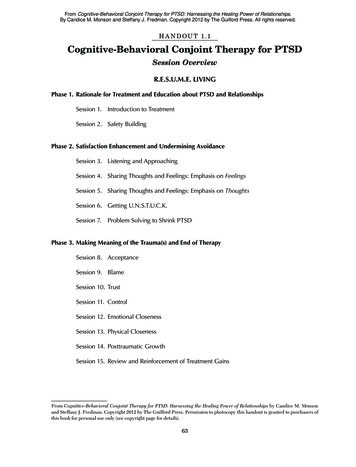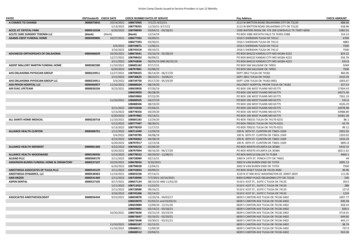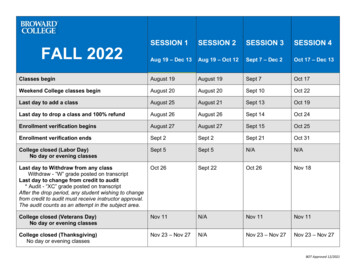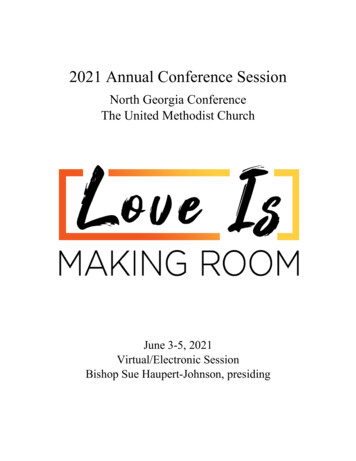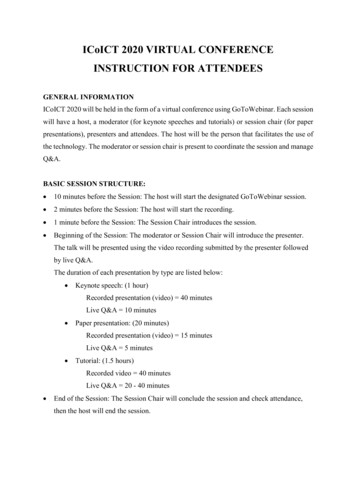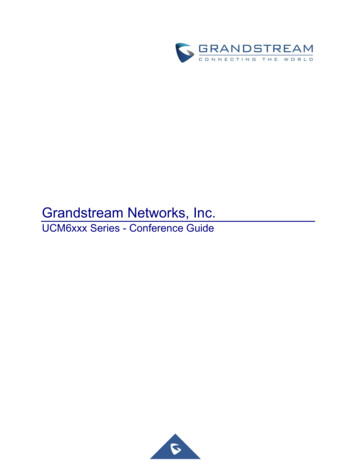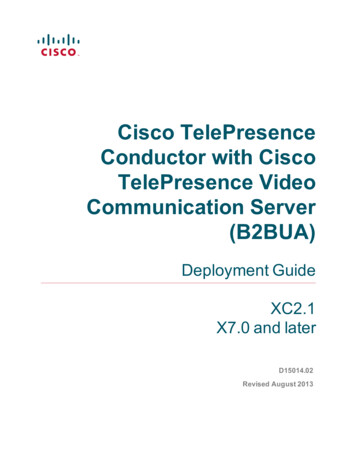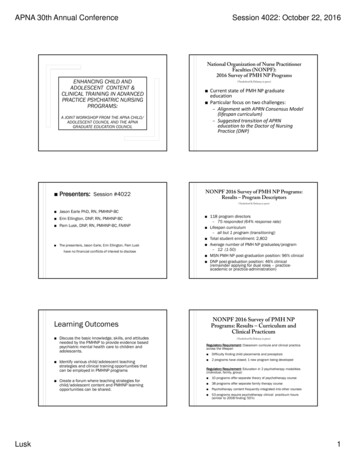
Transcription
APNA 30th Annual ConferenceENHANCING CHILD ANDADOLESCENT CONTENT &CLINICAL TRAINING IN ADVANCEDPRACTICE PSYCHIATRIC NURSINGPROGRAMS:A JOINT WORKSHOP FROM THE APNA CHILD/ADOLESCENT COUNCIL AND THE APNAGRADUATE EDUCATION COUNCIL Presenters: Session #4022Session 4022: October 22, 2016National Organization of Nurse PractitionerFaculties (NONPF):2016 Survey of PMH NP Programs(Vanderhoef & Delaney, in press) Current state of PMH NP graduateeducation Particular focus on two challenges:– Alignment with APRN Consensus Model(lifespan curriculum)– Suggested transition of APRNeducation to the Doctor of NursingPractice (DNP)NONPF 2016 Survey of PMH NP Programs:Results – Program Descriptors(Vanderhoef & Delaney, in press) Jason Earle PhD, RN, PMHNP-BC Erin Ellington, DNP, RN, PMHNP-BC Pam Lusk, DNP, RN, PMHNP-BC, FAANP The presenters, Jason Earle, Erin Ellington, Pam Luskhave no financial conflicts of interest to discloseLearning Outcomes Discuss the basic knowledge, skills, and attitudesneeded by the PMHNP to provide evidence basedpsychiatric mental health care to children andadolescents. Identify various child/adolescent teachingstrategies and clinical training opportunities thatcan be employed in PMHNP programs Create a forum where teaching strategies forchild/adolescent content and PMHNP learningopportunities can be shared. 118 program directors– 75 responded (64% response rate) Lifespan curriculum– all but 1 program (transitioning) Total student enrollment: 2,802 Average number of PMH NP graduates/program– 12 (1-50) MSN PMH NP post-graduation position: 96% clinical DNP post-graduation position: 46% clinical(remainder applying for dual roles – practiceacademic or practice-administration)NONPF 2016 Survey of PMH NPPrograms: Results – Curriculum andClinical Practicum(Vanderhoef & Delaney, in press)Regulatory Requirement: Classroom curricula and clinical practicaacross the lifespan Difficulty finding child placements and preceptors 2 programs have closed; 1 new program being developedRegulatory Requirement: Education in 2 psychotherapy modalities(individual, family, group) 10 programs offer separate theory of psychotherapy course 38 programs offer separate family therapy course Psychotherapy content frequently integrated into other courses 53 programs require psychotherapy clinical practicum hours(similar to 2008 finding: 50%)Lusk1
APNA 30th Annual ConferenceSession 4022: October 22, 2016More In‐Depth Teaching on theCommon Psychiatric DisordersReferencesVanderhoef, D. M. & Delaney, K. R. (in press). NationalOrganization of Nurse Practitioner Faculties: 2016 Surveyof Psychiatric Mental Health Nurse Practitioner Programs.Journal of the American Psychiatric Nurses Association. Neuropathophysiology: A LifespanApproach Psychopharmacology Major Psychopathological Disorders Psychiatric Assessment Across theLifespanDNP ClinicalPractica Evidence‐Based Treatment Group Therapy and Complex Care(Integration intoClinical Practice)(Pediatric ADHD, Anxiety,Depressive, and DisruptiveBehavior Disorders)Progressively Deepening KnowledgeThrough a Sequence of CoursesRush UniversityCollege of NursingEvidence‐Based TreatmentPsychopharmacologyPediatric AnxietyMolecular/Cellular ProcessesPediatric Anxiety andDevelopmentDan Siegel’s InterpersonalNeurobiology JASON EARLE PHD, PMHNP‐BCJASON ic Anxiety Neurocircuity Signaling the NucleusEmotion Generation CircuitEmotion Regulation CircuitOverview of Rush’s Psych DNPPopulation/Role Cognates and PracticaCurriculumUniversity of Missouri-Kansas CityErin Ellington, DNP, RN, PMHNP-BCPMHNP Track Coordinatorellingtone@umkc.edu Neuropathophysiology: ALifespan Approach Psychopharmacology Major PsychopathologicalDisorders Psychiatric Assessment Acrossthe LifespanDNP ClinicalPractica Evidence‐Based Treatment Group Therapy and Complex CareLusk2
APNA 30th Annual ConferenceSession 4022: October 22, 2016Enhancing Child and AdolescentContentUMKC PMHNP Program 53 credit hours660 psychiatric clinical hoursFull‐time, part‐time, post‐MSNSeamless entry to DNP if desired4 core psychiatric courses (16 hrs) Pediatric Behavioral Health IntegrationAdolescent SBIRTCognitive Behavioral TherapyClinical Training Sites– Didactic & clinical– Full lifespanChild and Adolescent Content ReadingCase studiesDiscussion boardExam questionsLecturesClinical trainingTherapy & medication managementEnhancing Child and AdolescentContentPediatric Behavioral Health Integration Didactic– Pediatric primary care– Advantages/disadvantages– Collaborative Care vs Integrated Care– SAMHSA Levels of Integration and Competencies http://www.integration.samhsa.gov/ Case examples Clinical trainingAdolescent SBIRT Grant– HRSA Behavioral Health Workforce Education andTraining for Professionals– Develop and expand the substance abuse andmental health workforce who will focus onchildren, adolescents, and transitional‐age youth– Emphasis is on prevention and clinicalinterventionThis work supported by grant G02HP27985 from theDepartment of Health and Human Services, SubstanceAbuse and Mental Health Services centers/content.aspx?rc midamerica&content STCUSTOM53
APNA 30th Annual ConferenceAdolescent SBIRTSession 4022: October 22, 2016Clinical Training Site Local Kansas City sites– Inpatient– Outpatient– Residential– Primary care Distance sites– Student‐led search; faculty‐assisted recruitmentCognitive Behavioral TherapyFuture Plans Workshop: 8‐hour training session with an Beck trainer Enhanced pediatric psychopharmacologymodules Pediatric telepsychiatry didactic andexperiential training Educational integration with PNP students Expand CBT for younger children, play therapy,and family therapy Child/adolescent content for Adult PMHNP– Lecture, video, roleplays, Q&A CBT basics: cognitive model, cognitive caseconceptualization, session structure, treatment Emphasis: depression and anxiety disorders– Cognitive restructuring, exposure exercises for anxiety, andbehavioral activation for depression Population: adolescent, transitional age, young adult Considerations: brief CBT services & E/M add‐onCognitive Behavioral Therapy 1‐hr initial assessment on a transitional agestandardized patient Complete the Beck Cognitive Case Writeup– (Beck, 2011) Overwhelmingly positive student feedback– Increased understanding of and confidence in theirability to provide CBT– Some interest in post‐graduation training in CBT– Students were better‐equipped to participate moreeffectively in their psychotherapy preceptorshipsLuskReferences Beck, J. (2011). Cognitive therapy: Basics and beyond. New York, NY:Guilford Press. Heath B, Wise Romero P, and Reynolds K. (2013, March). A StandardFramework for Levels of Integrated Healthcare. Washington, D.C.:SAMHSA‐HRSA Center for Integrated Health Solutions. Hoge M.A., Morris J.A., Laraia M., Pomerantz A., & Farley, T. (2014).Core Competencies for Integrated Behavioral Health and PrimaryCare. Washington, DC: SAMHSA ‐ HRSA Center for Integrated HealthSolutions. Mid‐America ATTC. (n.d.) Screening, Brief Intervention and Referral toTreatment (SBIRT) Resources. Retrieved t.aspx?rc midamerica&content STCUSTOM54
APNA 30th Annual ConferenceSession 4022: October 22, 2016ANA Scope of Practice (2014)Faculty Delivered Clinical training in Psychotherapyfor PMHNP students:CBT for Children and AdolescentsONLINE, IN CLASS & HYBRID PROGRAMSStandard 5F. PsychotherapyThe Psychiatric‐Mental Health Advanced Practice Registered Nurseconducts individual, couples, group and family psychotherapy usingevidence‐based psychotherapeutic frameworks and nurse‐patienttherapeutic relationships.PA M L U S K , D N P, P M H N P ‐ B C , FA A N PP R O F E S S O R , C O O R D I N ATO R P M H N P P R O G R A ME A S T E R N K E N T U C KY U N I V E R S I T YObjectives:ANCCDiscuss the need for PMHNP students to have clinical training inpsychotherapy modalities, including the opportunity to developpsychotherapy skills through direct supervised experiences as corecontent in PMHNP programs.PMHNP Board Certification Exam eligibility requirements: Physical assessment, pathophysiology, pharmacologyIdentify the basic competencies (knowledge, skills, and attitudes) inpsychotherapy (cognitive behavioral therapy and group psychotherapy)that are the basis for clinical training of PMHNP studentsContent in: Health promotion and/or maintenance Differential diagnosis and disease management, including the use andprescription of pharmacologic and nonpharmacologic interventionsIdentify teaching resources and student evaluation tools / outcomemeasures for clinical training in psychotherapy in PMHNP programs.AND clinical training in at least twopsychotherapeutic treatmentmodalities.GAPGraduate Programs for AdvancedPractice Nurses ‐Our Fourth “P”Describe strategies for delivery of clinical training in psychotherapy inPMHNP programs, including online, in class, or hybrid delivery.To be eligible to sit for the ANCC board certification exam, PMHNP students arerequired to have clinical training (didactic and experiential) in 2 forms ofpsychotherapy. Graduate faculty are challenged to make psychotherapy trainingand clinical skill practice available for all their specialty students.Brick & Mortar students:Physical AssessmentPharmacologyPathophysiologyLack of preceptor therapistsTraining InstitutesOnline Students:PSYCHOTHERAPYDiverse geographical areasLusk5
APNA 30th Annual ConferenceCompetencies for PsychotherapistsGeneric Therapeutic Competencies ‐“The competencies needed to relate to people and to carry out anyform of psychological intervention.”Roth, A. & Piling, S. (2008). Using an evidence‐based methodology to identify the competenciesrequired to deliver effective cognitive and behavioural therapy for depression and anxietydisorders. Behavioral and Cognitive Psychotherapy. 36, 129‐147.Session 4022: October 22, 2016CBT with Children & AdolescentsGroup TherapyAn 8 week clinical training module has been developed and delivered thatprovides knowledge and skill practice for PMHNP students in psychotherapy.The module is competency based ‐ teaches psychotherapy knowledge, skills,and attitudes while providing experience in group psychotherapy and cognitivebehavioral psychotherapy with children and adolescents.Data: PMHNP student post clinical training evaluations have been collected andare being analyzed from groups of PMHNP students representing the 6 cohorts. Online HybridCOPE Training and online group experience – 7 weeksIn Person COPE Training and online group experience – 7weeks In Class COPE Training and “brick and mortar” COPE groups withfaculty, face to faceEastern Kentucky University, St. Francis University, University of ArizonaUniversity of California, San Francisco, Vanderbilt University3 Types of Graduate ProgramsBasic Therapeutic CompetenciesKnowledge and understanding of mental health problemsKnowledge of, and ability to operate within professional and ethical guidelinesKnowledge of a model of therapy, and the ability to understand and employ themodel to practiceAbility to engage clientAbility to foster and maintain a good therapeutic alliance, and grasp the client’sperspective and“world view”Ability to deal with emotional content of sessionsPresentation of the model we have used to teach psychotherapy with 5different graduate cohorts – one distance – online presentation only, one in‐class, in a large city University, and one hybrid program, with in personworkshop “immersion” and online group sessions. Competency‐based teachingmaterials, and student/ training workshop evaluation tools. ONLINE BRICK & MORTAR HYBRIDAbility to manage endingsAbility to undertake generic assessment (relative history and identifyingsuitability for intervention)Ability to make use of supervisionTeaching Strategy:Basics and Beyond : Primary TextTo share a successful strategy for providing PMHNPstudents clinical training in two modalities ofpsychotherapy in a format delivered to a totallyonline cohort, a traditional campus based cohort,and students in a hybrid program with week long oncampus immersions.Beck, J. (2011). Cognitive therapy: Basics and beyond. New York, NY: Guilford PressLusk6
APNA 30th Annual Conference7 Sessions: Group DeliveryThe Clinical Training :A clinical training experience has been developed and delivered byPMHNP faculty to students in an Online PMHNP program, a traditionalon Campus University based PMHNP program, and a hybrid onlineprogram with on campus summer immersions. The students received acontent based workshop on Cognitive Behavior Therapy (CBT) basicsand adaptation of CBT for children and adolescents.The didactic workshop was followed by weekly small group sessions (for7 weeks) that allowed the students to lead and experience being amember of a therapy group as they learned the process of CBT. Weused a CBT 7 session manual for adolescents in the weekly sessions.Student outcomes were measured, and data analyzed for commonthemes. Students in the group sessions,(face‐to‐face and online,reported that they learned how to do CBT, group process, stages ofgroup psychotherapy and also how CBT is developmentally presented toadolescents and childrenThe process:Session 4022: October 22, 2016Thematic analysis revealed greater understanding of CBT through the simplicity andorganization of the COPE sessions. Students also benefited from their peerinteraction and felt safe practicing this new skill in a group atmosphere.Future directions:This module can be delivered easily in anyPMHNP program and will provide thestudents with clinical training (active skilldevelopment with faculty supervision – aswell as didactic/ knowledge) in Grouppsychotherapy, Cognitive BehavioralPsychotherapy and evidence basedpsychotherapy for children andadolescents.References:American Psychiatric Nurses Association. (2014). Psychiatric‐Mental Health Nursing: Scopes andStandards of Practice (2nd Ed. Silver Springs, MD; Nursebooks .org.Faculty RoleBasics of CBT: SupervisedPracticeStudent FeedbackEvaluation Tool: anonymousafter 7 sessions of COPEpracticeBeck CTRS –CognitiveTherapy Rating ScaleBeck, J. (2011). Cognitive therapy: Basics and beyond. New York, NY: Guilford Press.Lusk, P. & Melnyk, B.M. (2011). The brief cognitive‐behavioral COPE intervention for depressedadolescents: Outcomes and feasibility of delivery in 30 minute outpatient visits. Journal of theAmerican Psychiatric Nurses Association. 17(3), 226‐236.Lusk, P. & Melnyk, B.M.(2011). COPE for the treatment of depressed adolescents: Lessons learnedfrom implementing an evidence‐based practice change. Journal of the American Psychiatric NursesAssociation. 17(4), 297‐309.Melnyk, B. (2013). COPE (Creating Opportunities for Personal Empowerment) for Teens: A 7‐SessionCognitive Behavioral Skills Building Program (3rd edition). Columbus: COPE2ThriveRoth, A. & Piling, S. (2008). Using an evidence‐based methodology to identify the competenciesrequired to deliver effective cognitive and behavioural therapy for depression and anxietydisorders. Behavioral and Cognitive Psychotherapy. 36, 129‐147.Wheeler, K. (Ed.) (2014). Psychotherapy for the advanced practice psychiatric nurse. New York, NY:Springer.Lusk7
education to the Doctor of Nursing Practice (DNP) NONPF 2016 Survey of PMH NP Programs: . University of Missouri-Kansas City Erin Ellington, DNP, RN, PMHNP-BC PMHNP Track Coordinator ellingtone@umkc.edu. APNA 30th Annual Conference Session 4022: October 22, 2016 Lusk 3 UMKC PMHNP Program 53 credit hours 660 psychiatric clinical hours


